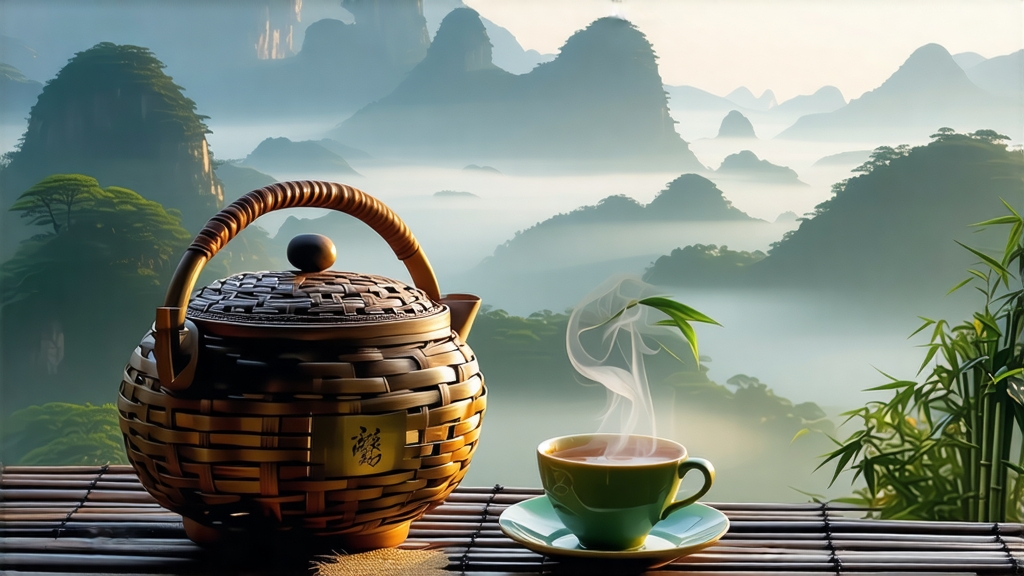
Tucked above the clouds on the northern rim of the Sichuan Basin, the Meng Ding range has been sending its morning vapors skyward for more than two millennia. Among the terraces carved into those granite slopes grows a tea so discreet that even seasoned drinkers often mistake it for a green tea: Meng Ding Huang Ya, literally “Meng Ding Yellow Bud.” Yet one sip reveals the difference—an extra, almost invisible step in the workshop that coaxes the leaf from verdant brightness into the color of antique parchment and the flavor of warm chestnuts drizzled with honey. This is the story of that transformation, and of the mountain, monks, merchants, and emperors who once guarded it as a state secret.
-
A leaf fit for an emperor
The first written record appears in a Tang-dynasty edict of 724 CE, when Emperor Xuanzong decreed that “the bud of Meng Ding, picked before the Qingming festival, shall enter the palace only.” For the next six centuries the tea was measured in gold, not silver, and carried southward in bamboo tubes sealed with wax and imperial chop. When the Song court moved to Hangzhou, the route lengthened but the ritual never changed: pluck at dawn, rush down the Min River, change horses in Chengdu, reach the Grand Canal before the lotus flowers opened. By the Ming, the tribute quota had risen to 400 kilograms a year, yet only the top 2 kg—taken from a single hillside known as Shangqing Peak—were reserved for the Son of Heaven. The rest trickled into monasteries, where monks brewed it in silence, believing the pale liquor helped “illuminate the mind’s eye.” -
Why “yellow”?
Chinese color nomenclature is poetic but also chemical. In green tea, de-enzyming is abrupt: leaves are thrust into a 280 °C wok within minutes of picking, locking chlorophyll and tannins in their youthful state. Yellow tea, by contrast, steals a pause. After the initial kill-green, the leaf is piled in thin layers inside linen bags and left to “smother” for 4–8 hours. During this sealed rest, surface moisture rehydrates the cell walls, re-activating gentle oxidation and hydrolysis. Chlorophyll degrades into pheophytin, catechins dimerize, and a whisper of starch converts into reducing sugars, painting the leaf a muted golden-green and rounding the astringency into something that resembles warm shortbread. The process is called men huang—“sealed yellowing”—and it is the invisible fingerprint that moves Meng Ding Huang Ya out of the green-tea genealogy into a class of its own. -
Micro-climate in a cup
Meng Ding sits at 29° N, 1,450 m above sea level, where the Sichuan fog acts like a giant soft-box, scattering sunlight into a diffuse, blue-green glow. Average annual humidity hovers at 85 %, slowing photosynthesis and coaxing the plant to stockpile theanine instead of bitter polyphenols. Local growers often say their tea “drinks like mountain mist,” and chromatographic studies back the metaphor: Huang Ya contains up to 3.2 % theanine, almost double the level found in lowland green teas, while its EGCG ratio is correspondingly lower, explaining the creamy mouthfeel that appears within seconds of the first infusion. -
The five-day ballet
Harvest begins when the mountain azaleas bloom, usually the last week of March. Only the “flag-and-bud” set—one tender tip still sheathed in its two miniature leaves—is taken. By 9 a.m. the baskets are already downhill, where the mao qing (“rough green”) phase starts:
Day 1, morning: Sha Qing – 4 minutes in a 220 °C wok, hand-tossed 70 times per minute to rupture 30 % of the cell walls without cracking the skin.
Day 1, afternoon: Men Huang – leaves piled 8 cm deep, wrapped in wet linen, temperature held at 34 °C for 6 hours; turned every 45 minutes to dissipate CO₂.
Day 2: Zhuang Huang – low-temperature roasting at 90 °C on a bamboo brazier, shaping the leaf into the trademark “spear” form; moisture reduced to 20 %.
Day 3: Fu Huang – second sealed yellowing, this time only 3 hours, to equalize moisture gradients.
Day 4: Ti Xiang – “scent-lifting